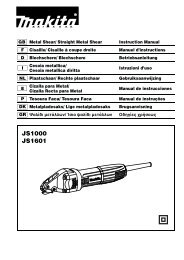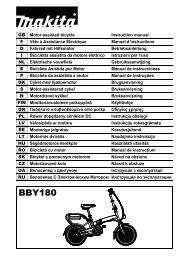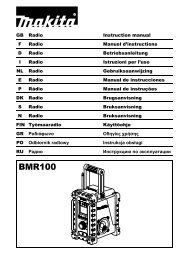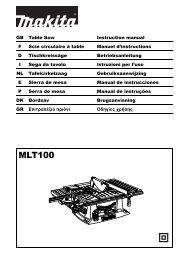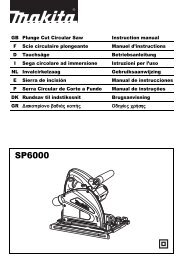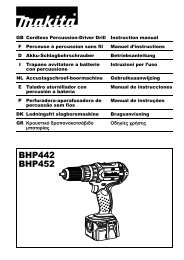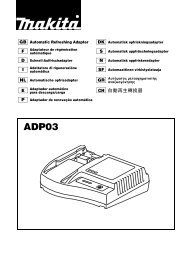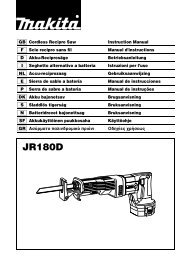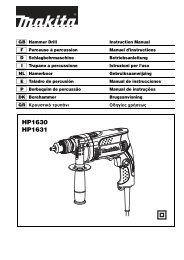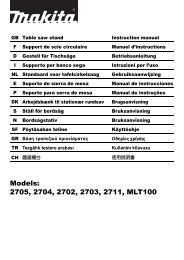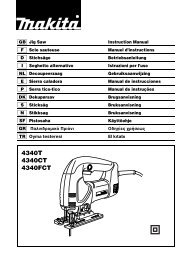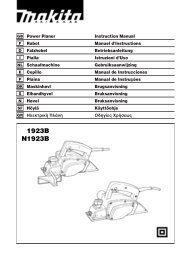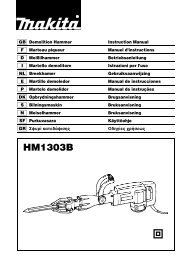Manual de instrucciones - Makita
Manual de instrucciones - Makita
Manual de instrucciones - Makita
Create successful ePaper yourself
Turn your PDF publications into a flip-book with our unique Google optimized e-Paper software.
ASSEMBLY<br />
CAUTION:<br />
Always be sure that the tool is switched off and<br />
unplugged before carrying out any work on the tool.<br />
Installing or removing trimmer bit (Fig. 3)<br />
CAUTION:<br />
Use only the wrenches provi<strong>de</strong>d with the tool.<br />
Insert the bit all the way into the collet cone and tighten<br />
the collet nut securely with the two wrenches.<br />
To remove the bit, follow the installation procedure in<br />
reverse.<br />
OPERATION<br />
Set the tool base on the workpiece to be cut without the bit making any contact. Then turn the tool on and wait until the<br />
bit attains full speed. Move the tool forward over the workpiece surface, keeping the tool base flush and advancing<br />
smoothly until the cutting is complete.<br />
When doing edge cutting, the workpiece surface should be on the left si<strong>de</strong> of the bit in the feed direction. (Fig. 4)<br />
NOTE:<br />
Moving the tool forward too fast may cause a poor quality of cut, or damage to the bit or motor. Moving the tool forward<br />
too slowly may burn and mar the cut. The proper feed rate will <strong>de</strong>pend on the bit size, the kind of workpiece and<br />
<strong>de</strong>pth of cut. Before beginning the cut on the actual workpiece, it is advisable to make a sample cut on a piece of<br />
scrap lumber. This will show exactly how the cut will look as well as enable you to check dimensions.<br />
When using the trimmer shoe, the straight gui<strong>de</strong> or the trimmer gui<strong>de</strong>, be sure to keep it on the right si<strong>de</strong> in the feed<br />
direction. This will help to keep it flush with the si<strong>de</strong> of the workpiece. (Fig. 5)<br />
CAUTION:<br />
Since excessive cutting may cause overload of the motor or difficulty in controlling the tool, the <strong>de</strong>pth of cut should<br />
not be more than 3 mm at a pass when cutting grooves. When you wish to cut grooves more than 3 mm <strong>de</strong>ep, make<br />
several passes with progressively <strong>de</strong>eper bit settings.<br />
Templet gui<strong>de</strong><br />
The templet gui<strong>de</strong> provi<strong>de</strong>s a sleeve through which the bit passes, allowing use of the trimmer with templet patterns.<br />
(Fig. 6)<br />
Remove the chip <strong>de</strong>flector.<br />
Loosen the screws and remove the base protector. Place the templet gui<strong>de</strong> on the base and replace the base protector.<br />
Then secure the base protector by tightening the screws. (Fig. 7)<br />
Secure the templet to the workpiece. Place the tool on the templet and move the tool with the templet gui<strong>de</strong> sliding<br />
along the si<strong>de</strong> of the templet. (Fig. 8)<br />
NOTE:<br />
The workpiece will be cut a slightly different size from the templet. Allow for the distance (X) between the router bit<br />
and the outsi<strong>de</strong> of the templet gui<strong>de</strong>. The distance (X) can be calculated by using the following equation:<br />
Straight gui<strong>de</strong> (Accessory)<br />
The straight gui<strong>de</strong> is effectively used for straight cuts<br />
when chamfering or grooving. (Fig. 9)<br />
Attach the gui<strong>de</strong> plate to the straight gui<strong>de</strong> with the bolt<br />
and the wing nut. (Fig. 10)<br />
Remove the chip <strong>de</strong>flector.<br />
Attach the straight gui<strong>de</strong> with the clamp screw (A).<br />
Loosen the wing nut on the straight gui<strong>de</strong> and adjust the<br />
distance between the bit and the straight gui<strong>de</strong>. At the<br />
<strong>de</strong>sired distance, tighten the wing nut securely.<br />
When cutting, move the tool with the straight gui<strong>de</strong> flush<br />
with the si<strong>de</strong> of the workpiece. (Fig. 11)<br />
If the distance (A) between the si<strong>de</strong> of the workpiece and<br />
the cutting position is too wi<strong>de</strong> for the straight gui<strong>de</strong>, or if<br />
the si<strong>de</strong> of the workpiece is not straight, the straight<br />
gui<strong>de</strong> cannot be used. In this case, firmly clamp a<br />
straight board to the workpiece and use it as a gui<strong>de</strong><br />
against the trimmer base. Feed the tool in the direction of<br />
the arrow. (Fig. 12)<br />
6<br />
Distance (X) =<br />
outsi<strong>de</strong> diameter of the templet gui<strong>de</strong> – router bit diameter<br />
2<br />
Circular work<br />
Circular work may be accomplished if you assemble the<br />
straight gui<strong>de</strong> and gui<strong>de</strong> plate as shown in Fig. 13 or 14.<br />
Min. and max. radius of circles to be cut (distance<br />
between the centre of circle and the centre of bit) are as<br />
follows:<br />
Min.: 70 mm<br />
Max.: 221 mm<br />
Fig. 13 for cutting circles between 70 mm and 121 mm in<br />
radius.<br />
Fig. 14 for cutting circles between 121 mm and 221 mm<br />
in radius.<br />
NOTE:<br />
Circles between 172 mm and 186 mm in radius cannot<br />
be cut using this gui<strong>de</strong>.



